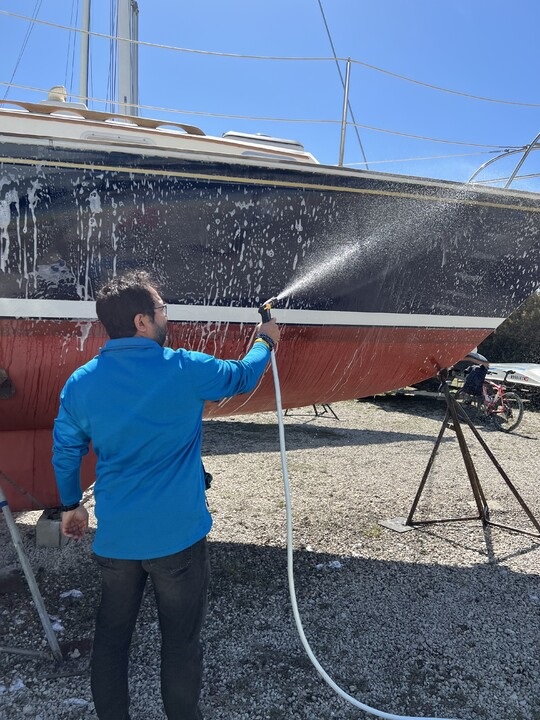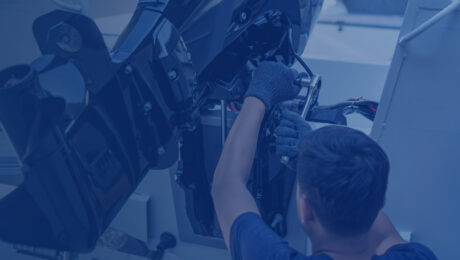Spring is officially here (spring astronomical equinox was on March 21), and it is time to start preparing and planning for the upcoming boating season! I know, some of you don’t feel that, especially as the winter is trying to make its last roar with near freezing temperatures in the North-East and across the country. However, within two-week’s time, most marinas will start launching boats and you want to make sure you are not left behind on the dry dock!
Whether it’s your first time commissioning your boat or not, and regardless of the type of boat you have, it is helpful to follow a commissioning protocol. There are a lot of action items, and you want to make sure you check all the boxes, so that you can launch as soon as you want to.
In addition to the following list, I am making a habit of creating a punch list of things to do/repair in the fall, when preparing a boat for haul-out. During the winter I am checking the list to see if there’s anything I can get a head start on, like ordering parts and materials or connecting with relevant professional service providers (such as a mechanic or a rigger). My fall punch list then becomes part of my spring commissioning list and I make sure everything on it is completed as well.
Make a schedule:
To many of us, life can get very hectic, and commissioning, if not pre-planned, may turn out to be the last priority. In order to avoid that, I recommend to put on your calendar at least 3 dates, on which you will do the following:
- Review and assessment
- Work on the boat
- Launch date
It might be best if you back-date these dates, eg: if you want to launch your boat on April 15, then you start planning the other two dates to be enough time before. Remember - you want to give yourself enough wiggle room to account for weather (which is extremely unpredictable this time of the year), availability of service providers, supply and shipping time of equipment and material you’ll need, your own personal life and other unexpected events. I would say that for boats that don’t have much on their fall punch list, it would be wise to make the review and assessment day about a month before launch. After that you should dedicate another full day of work to fixing and maintaining sometime in between the review & assessment date and the launch date.
Bottom paint:
Whether you are planning to paint the bottom of your boat on your own or hiring someone to do it for you, it is important to give at least a month's time ahead. Bottom paint requires applying several coats, but you need to make sure there’s enough time for the paint to dry in-between applications. If the weather is too cold (temperatures under 50f) or too humid (above 65% humidity), the painting schedule will be delayed.
If you are planning to paint the bottom on your own, before painting it is advisable to sand the bottom of the boat to remove the previous coat. Make sure to get protective equipment such as a respirator, eye protection, gloves, boatyard coveralls to protect your clothing and your skin, and work shoes/boots.
Capt. Nitzan’s Commissioning Punch List:
Click here for a printable version
Before you launch
Exterior
Boat bottom
- General bottom condition and re-paint if needed
- Prop(s) in place, rotating smoothly, and generally in good condition (look for chipping, signs of corrosion, or metal deterioration). Make sure the cotter pin is in place or replace it if it seems bent or not intact.
- On inboard motors, try moving the boat’s shaft by holding onto the prop. If it wiggles - you may need to replace the cutlass bearing.
- Place shaft zincs/collar anodes on your boat’s shaft as a sacrificial metal protecting the shaft and other underwater metals from galvanic corrosion.
- Inspect the rudder and the rudder stock - check for any visible damages and make sure the rudder stock isn’t bent.
- Check the hull for blisters, distortions, and stress cracks.
On deck
- Operate the wheel or tiller to ensure the steering works correctly.
- Make sure all lifelines, stanchions, and toe-rails are in place and in good condition.
- Inspect the anchor and rod, make sure that one end of the rod is attached to the boat while the attachment to the anchor is secure and in good condition. Clean and lubricate the anchor and chain as needed. Replace rusty chains and chafed/frayed lines.
- Inspect spring lines (dock lines) and for chafe and wear, consider renewing as necessary.
- If equipped, ensure that the stern under-waterline drain plug is installed.
- Make sure cockpit/deck above-waterline drains are clear and clean. Replace strainers as needed.
- Check your shore power cable connections, look for burns or extreme bends which will require replacing the shore power. Do not use a cable that has a burnt connector as it might cause an electric breakdown and even an electric fire. Make sure the boat outlet is in good condition and dry.
Sailboat Rig
- Inspect swage fittings for cracks and heavy rust.
- Inspect line inventory: halyards, sheets, travelers, spring lines. Make sure all lines are in good condition, consider replacing lines as needed.
- Inspect all stays and shrouds for fraying. If you recognize standing rigging issues - make sure to plan to make adjustments and replacements once the boat launches as it is unsafe to do so while on the hard. Lineup a professional rigger as needed.
- Remove tape on turnbuckles and spray threads with a lubricant, preferably Teflon.
- Replace old tape with fresh tape. If you suspect the core around a chainplate is damp, remove the chainplate to inspect and make repairs.
Interior
- Inspect all hoses and make sure they are not overly stiff, rotting, leaking or cracking. Make sure all hoses are in place and snugged neatly.
- Inspect all hose clamps and replace as necessary. Make sure to double clamp fuel lines and exhaust hoses with marine-rated stainless hose clamps.
- Make sure all sea cock valves are lubricated, operating smoothly and clean of corrosion.
- Check the condition of through-hulls, make sure they are clean, not bent and that liquid can run freely through them.
- Use a garden hose to check for water leaks at portholes, hatches and companionways. Renew sealant or replace equipment as necessary.
- Test bilge pump operation (might need to charge batteries for that - you can get a portable battery charger in home improvement stores or perhaps plug your boat to a post in the yard if available).
- Check stove and propane or liquified petroleum gas (LPG) tanks for loose fittings and leaking hoses.
Inboard Engines and Fuel Systems
- Clean or replace engine’s sea water filters.
- Inboard engines: check the shaft and rudder stuffing boxes for correct adjustment. A stuffing box should leak no more than two drops each minute when the prop shaft is turning.
- Inspect all fuel lines, including fill and vent hoses. In particular look for softness, brittleness or cracking. Check all joints for leaks, and make sure all lines are well supported and secured with noncombustible clips or straps with smooth edges.
- Inspect fuel tanks, fuel pumps and filters for leaks. Replace fuel filters, and make sure to have spare filters for the season (it is recommended to change a fuel filter every 100 hours on a gas engine and every 250 hours on diesel engines)
- Charge your boat’s batteries (you can get a portable battery charger in home improvement stores or perhaps plug your boat to a post in the yard if available). Clean and tighten electrical connections, especially both ends of battery cables, preferably replace wing nuts with regular nuts. Make sure batteries are secured and fastened by straps to prevent moving around. Consider placing the batteries within a PVC protective case to prevent leaks into the bilge. If applicable - wire-brush battery terminals and fill cells with distilled water.
- Check bilge blower hose for leaks and run blower to confirm correct operation.
- On inboard boats it is recommended to remove and inspect exhaust manifolds for corrosion once every few years.
Engine Outdrives and Outboards
- Inspect rubber outdrive bellows for cracked, dried and/or deteriorated spots (look especially in the folds) and replace as necessary.
- Check power steering and power trim oil levels.
- Inspect outer jacket of control cables for cracks or swelling. If needed - replace cables.
- Inspect lower unit oil level, in sterndrives and outboards, top up as necessary.
Trailers
- Check air pressure on tires and make sure you have a spare tire.
- When tire treads and sidewalls are cracked or eroded consider replacing the tire.
- Inspect wheel bearings and repack with grease as necessary.
- Test lights, and replace any broken bulbs or lenses.
- Inspect the winch and the hitch chains.
- Sand and paint rusty areas on the trailer frame to prevent further deterioration.
- Inspect brakes and brake fluid reservoir.
Safety Equipment
- Flares: Check expiration dates on flares. Tip: Keep expired flares handy and as you can use them first in case of emergency, so that way you have non-expired flames as backup or remaining after use of old ones.
- Fire Extinguishers:
- Replace disposable dry chemicals fire extinguishers that are older than 12 years. Make sure there wasn’t a recall by your fire extinguisher manufacturer.
- Service rechargeable fire extinguishers annually at a local certified fire equipment dealer.
- Make sure your fire extinguisher inventory is in compliance with the latest USCG regulations taking effect on April 20, 2022.
- Life Jackets:
- Make sure you have USCG approved properly sized and wearable life jackets in good condition for each passenger, including kids.
- Check inflatable life jacket cylinders and replace as needed.
- Check the inflatable piece by manually blowing into the mouth pump and make sure there is no air leak, otherwise - consider replacing the life jacket.
- Alarms: test smoke, carbon monoxide, fume and bilge alarms.
- Lights: check running, steaming, anchor and deck lights and make sure to have spare bulb inventory.
- Aids to navigation: update paper charts and download updates to your chart plotter software/application.
- First Aid Kit: replenish items that may have been used last season.
- Radio: check the operation of VHF radio(s) and that the MMSI number is correctly programmed.
- Vessel Safety Checks: get a free vessel safety check from the US Coast Guard Auxiliary or US Power Squadrons. Find out more at SafetySeal.net.
Boat Documents
- Make sure your boat registration is up to date. Remember to renew your dinghy and trailer registrations as well based on your state’s regulations.
- Make sure your boat registration IDs are displayed on your boat/dinghy/trailer in accordance with your state’s regulations.
- Review your boat insurance policy and update coverage if needed. Request a free quote from Ahoy! Insurance at ahoy.insure. Make sure to include your marina and/or club as an additional insured on the policy and provide them with a copy of your policy.
For Launch Day
Before you launch
- Visit the slip you will be docking the boat:
- Make sure that the shore power post is operating.
- Familiarize yourself with the location of deck cleats and make sure they are firmly attached to the dock.
- Check how wiggly is the dock to avoid surprises when stepping off the boat onto the dock for the first time.
- Alert your marina if any of the above are not in good condition so they can make repairs in advance or allocate you to a different slip until all is fixed.
- Consider placing a step stool to help step off the boat if the deck is too high.
- Make sure to close all seacocks prior to launch (you will test by opening them while in the water)
- Place dock lines on bow and stern as well as fenders on both sides of the boat before launch - so that in case you need to tie up to a dock nearby - they are readily available.
- Have a boat hook handy.
After you launch - while the boat is still in the sling
- Open seacocks of engine water intake, head intake and gray water drain - wait a couple of minutes to make sure there are no leaks or taking in water.
- After confirming there are no leaks - start the engines - make sure water is coming out of the exhaust, engage gear forward, the neutral and finally in reverse (no throttle) and make sure the boat is moving as expected.
- If all is ok - you can give an a-ok to the launch operator to release you from the sling and you can motor over to your slip.
- If there are any major issues - the launch can lift the boat out of the water for a local inspection, or even back to dry storage for further work.
At the slip
- Tie up the boat, adjust fenders as needed
- Plug in the shore power and make sure the batteries are charging
- Flush freshwater tank from antifreeze, fill it with fresh water and consider adding water treatment.
On a mooring
- Make sure the boat is tied up properly to the mooring using bridles
- Since no shore power is available - consider getting solar panel chargers as well as make sure to turn off all batteries when away to prevent battery drainage.
- Make sure your bilge pump is wired directly to the battery so that it is working even in case the battery switch for the boat is off.
Sailboat
Now that the boat is in the water it is time to make any rig adjustments or replacements needed. If all is in operable condition:
- Replace lines as needed.
- Put up the sails, dowse, furl or stow as needed.
Happy boating season!
Read our latest blog posts
What is a float plan and how do I create one?


